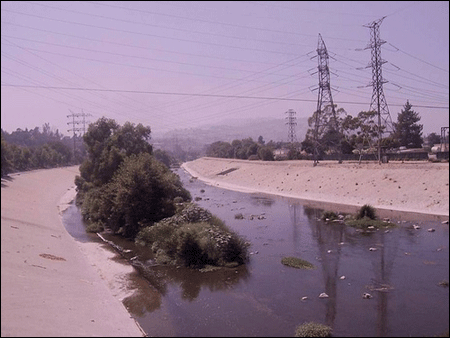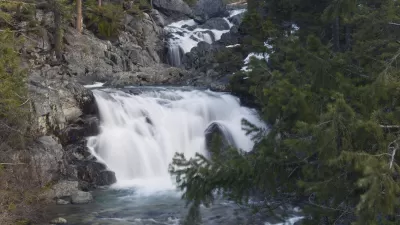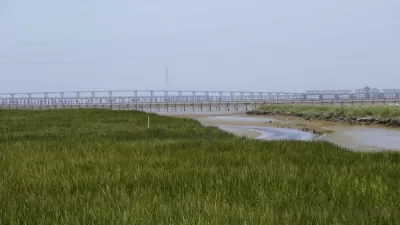Planetizen's Assistant Editor Nate Berg investigates the impact of recent court decisions on the Los Angeles River, and how it may affect development on the watersheds of rivers and waterways across the country.
For the federal government to protect waterways like rivers and streams, they have to ask one basic question: Is this water navigable? It seems simple enough, but hidden in this straightforward question is a jungle of nuance and intricacy. For waterways, how this question is answered can literally make or break them. But more likely, it will just make things kind of fuzzy, which is exactly what happened when the Army Corps of Engineers set out to determine how to regulate the Los Angeles River.
The trouble all started in 2006 when the Supreme Court of the United States released a new interpretation of the landmark 1972 environmental law known as the Clean Water Act. The court's reinterpretation added some new language to the law that has made answering the question of navigability much more difficult. As a result, any permits for development at or near a waterway now require a closer examination by the Army Corps to determine which, if any, federal regulations apply.
When a permit request came through this spring for a development in the upper watershed of the Los Angeles River, the Corps had to re-consider the river through the in light of the Supreme Court's ruling. What they eventually decided raised some eyebrows and some concerns.

Totaling less than four miles, only two sections of the 51-mile river were declared "traditionally navigable waters" by the Corps, the legal definition that gives waters the most protection under the Clean Water Act. Many in the environmental movement were surprised by how little of the river could be called "navigable" – especially those who've actually navigated the river by boat -- but officials at the Corps say even those four miles were not easy to prove.
The Question of Navigability
"In the arid parts of the country it is not easy to find traditional navigable waters," says David Castanon, Chief of the Regulatory Division for the Corps' Los Angeles District. "And we worked hard to find enough evidence to make that designation."
As one of the highest profile interpretations of the Clean Water Act since the 2006 decision, the L.A. River designation is one that has been closely watched. As other areas of the country are forced to make decisions about the protection of their own waterways, it could become the new model This potential influence has some people worried.
"There's not a lot of confidence at this point that the decision is going to be one that is good for the environment in the end," says Sean Hecht, executive director of the Environmental Law Center at the University of California Los Angeles School of Law.
The entire length of the L.A. River is still fully protected by the Clean Water Act, according to the Corps, but the new designation changes the protections afforded to the river's watershed – an area covering nearly 400 square miles. Some areas near the river or its tributaries may lose protections under the Clean Water Act, a change that could bring new development into those areas.
"I've been told that there will be a list of projects that will be lining up," says Ed Reyes, Los Angeles city councilman and chairman of the Los Angeles Ad Hoc River Committee. "That's the rumor. But knowing how the market behaves and knowing how opportunistic development can be, I wouldn't be surprised if we start seeing a rise in these applications."
And that could be the case throughout the entire country.
Reduced Jurisdiction
"Certainly now the test is narrower than it used to be, so one would expect that it's likely that fewer waterways would be protected," Hecht says.
Castanon at the Army Corps agrees that the Supreme Court's decision is going to reduce the amount of jurisdiction the federal government has over waterways.
"The question is, is it going to be a very modest, very minor reduction, or is it going to be more significant? We won't really know that until we have a chance to go through and make decisions," he says.
But making those decisions is harder than ever for the Army Corps of Engineers. The Supreme Court's 2006 decision in the cases of John A. Rapanos versus the United States and June Carabell versus the U.S. Army Corps of Engineers actually resulted in three separate opinions, none carrying a majority. Now referred to as the Rapanos decision, the most conclusive determination the fractured court made was that for any part of the watershed to receive protection under the Clean Water Act, it must have a "significant nexus" to downstream navigable waters. But no one seems to be very clear on what exactly a "significant nexus" is, or what makes a waterway "navigable".
"Prior to the Rapanos decision by the Supreme Court, we didn't really worry about any of this," says Castanon. "All we had to know was whether or not the waterway in question, -- even if it was an ephemeral dry streambed -- whether or not it connected ultimately to other waters that ultimately connected to the ocean."
"It's brought a lot of confusion to the game," says Jason Brush, an environmental protection specialist and acting manager of the Wetlands Regulatory Office in the U.S. Environmental Protection Agency's southwest region.
New 'Technical Rigor'
The Supreme Court's Rapanos decision has changed the way regulators look at the navigability of waterways. Brush says that waters can either be "traditionally navigable" -- like a broad and flowing river -- or "relatively permanent" -- like a streambed that only carries a significant amount of water after big storms. But despite these new definitions, Brush says that deciding whether or not waters are navigable is nothing new.
"The thing to keep in mind here is they've always been in question. They always have," Brush says. "What's different is that it might take you a lot longer to get that determination because the technical rigor that's required has increased substantially. But the rules of the game are the same."
Determining whether certain areas in the watershed have a "significant nexus" to those waters is a new challenge for regulators, and many say the resources required to prove a connection will be prohibitive.
"To demonstrate a significant nexus between some really small stream high up in the watershed and the end or mouth of the Los Angeles River is quite a difficult undertaking to ask the Corps of Engineers to do," says Ed Hopkins, director of the Environmental Quality Program for the Sierra Club. "And still it's not clear what the standards are for doing that."

Many worry that this ambiguity will mean the loss of protections for many watershed areas, especially those where water flows periodically, sometimes only once every few years. Castanon warns that it's much too early to say what the effect will be.
"People are just assuming that because we have to go through these new extra tests for significant nexus that much of the watershed could be lost," Castanon says. "That's premature to come to that conclusion. We don't know that yet."
Whether a property has a significant nexus is a determination that will have to be made on a case-by-case basis, according to Castanon. But some, like Sean Hecht, say the question of significant nexus isn't really a question at all.
"The whole scheme is not really scientifically sound," he says. "What the courts are looking at and have historically looked at and continue to look at is surface hydrological connections between different bodies of water. We know that there can be very important connections between bodies of water that are not on the surface. Water quantity is deeply affected by what happens underground, and the idea that the surface connections make a difference itself is something that doesn't really track scientific knowledge."
"In terms of what is a significant nexus and what does that mean, you know, those are all judgment calls," Hecht says. "I'm not a scientist, but I don't know that any scientist would really feel like they could weigh in on what a phrase like that actually means."
Concerns in L.A. and Beyond
Regulators are expected to face the prospect of making those judgment calls more and more as a result of the Supreme Court's decision and the L.A. River ruling. Though there are some concerns in the scientific and environmental communities about the loss of protections, the effects may not be as drastic as it seems. Local regulations often go farther than federal regulations in protecting the environment. This is especially true in states like California, where state-level environmental protections are some of the strongest in the nation. But other states, like Arizona, have limited their environmental regulations to be no more strict than those of the federal government.
"I think other Corps districts will look at this. And I think it will certainly be a precedent for that district," says Hopkins of the Los Angeles district, which includes Southern and Central California, and some parts of Nevada and Arizona.
The greater effect of the L.A. determination remains to be seen, but some aren't waiting around to find out. Minnesota Congressman James Oberstar has introduced a bill that would update the Clean Water Act to replace the phrase "navigable waters of the United States" with simply "waters of the United States". The Clean Water Restoration Act of 2007 has generated a lot of debate amongst lawmakers, but has not moved beyond committee in either the House or the Senate.
In the meantime, the Los Angeles River is stuck with its two sections of "traditionally navigable waterways" -- and a lot of questions about what's going to happen next.
L.A. City Councilman Ed Reyes says the ruling may actually turn out to be a good thing for the river, as it could encourage officials to revisit how the river and its watershed are regulated at the local level.
"We need to give the region and the watershed much more attention," Reyes says. "With this kind of ruling, it's going to force us to look at that and put the necessary dollars to make it happen."
No matter what officials do to respond, it's likely that the Corps' decision will end up being more important for the future of watershed development in the United States than it is for the Los Angeles River.
Nate Berg is Planetizen's assistant editor.

Planetizen Federal Action Tracker
A weekly monitor of how Trump’s orders and actions are impacting planners and planning in America.

Trump Administration Could Effectively End Housing Voucher Program
Federal officials are eyeing major cuts to the Section 8 program that helps millions of low-income households pay rent.

The 120 Year Old Tiny Home Villages That Sheltered San Francisco’s Earthquake Refugees
More than a century ago, San Francisco mobilized to house thousands of residents displaced by the 1906 earthquake. Could their strategy offer a model for the present?

Op-Ed: Looking for Efficiency? Fund Intercity Buses
Much less expensive than rail, intercity buses serve millions of Americans every year, but public subsidies are lacking.

Philadelphia Councilmember Proposes Transit Access Fund
The plan would allocate 0.5 percent of the general fund toward mobility subsidies for low-income households.

Texas Bill Would Ban Road Diets, Congestion Pricing
A Texas state senator wants to prevent any discussion of congestion pricing and could suspend existing bike lane and sidewalk projects.
Urban Design for Planners 1: Software Tools
This six-course series explores essential urban design concepts using open source software and equips planners with the tools they need to participate fully in the urban design process.
Planning for Universal Design
Learn the tools for implementing Universal Design in planning regulations.
Ada County Highway District
Clanton & Associates, Inc.
Jessamine County Fiscal Court
Institute for Housing and Urban Development Studies (IHS)
City of Grandview
Harvard GSD Executive Education
Toledo-Lucas County Plan Commissions
Salt Lake City
NYU Wagner Graduate School of Public Service





























